|
1.
CENTRAL AND WEST AFRICA
Regional update
Gabon
Power shortages remain a critical issue with daily
electricity cut now occurring twice a day. These
interruptions are disrupting industrial activity and creating
frustration among operators. On 15 September
construction work on the Owendo gas-fired thermal power
plant began. This constitutes the initial link in an
infrastructure project financed by the African Export-
Import Bank.
See: https://www.lenouveaugabon.com/fr/energies/1709-20614-afreximbank-injecte-130-milliards-fcfa-pour-trois-centrales-a-gaz-de-300-mw-au-gabon
Demand remains weak with European buyers being
cautious and Chinese interest being limited. The
competitive threat from Brazilian pine is a central concern
creating downward pressure on Okoume’s market share.
Okoume is facing growing competition from Brazilian
pine. News is circulating that a new, large-scale automated
sawmill in Brazil is offering sawn pine at Eur210–
220/cu.m CIF in Middle East makets. This is under-cutting
Okoume in one of its key export destinations and
contributing to sluggish sales and the build-up of stocks.
At the GSEZ Park in Nkok it is reported that Okoume
stocks have climbed to around 30,000 cu.m. This
accumulation reflects both weak demand and high
production levels during the dry period.
SETRAG is facing new criticism after a major fire at its
log stock park in Lastourville. The blaze, fuelled, it is said,
by sawdust and offcuts spread quickly and damaged some
Okoume stock. Those affected are demanding
compensation.
Regulatory developments
On 9 September the Gabon Forestry Ministry and the
Ministry of Economy and Finance hosted an Economic
Forest Forum. Operators were reminded that in 2023 the
forestry sector contributed 41.9 billion CFA in taxes,
equivalent to 3.2% of GDP, a level described by officials
as too low given Gabon’s forest coverage.
The government is seeking to increase revenue and
improve sector governance.
Several initiatives were presented under the new “Fonds
Bois Gabon 2030”, including:
+ reform of the forestry code (previous attempts failed)
+ stronger certification requirements
+ stricter enforcement of tax payments
+ an emphasis on downstream processing including furniture
+ geolocation for timber trucks using European style tachograph discs
It is said that currently 172 trucks in the GSEZ are
equipped with such a system but the country has a total of
450 trucks requiring installation.
Cameroon
The country is firmly in election mode ahead of the
October presidential polls. Political uncertainty is keeping
operations on hold with many companies scaling back
production until the elections are over. It is suggested that
trade missions and investment decisions are likely to
resume only in November.
Markets remain mixed across all regions. Demand in the
Middle East is reported as stable for redwood species
while Ayous is under pressure due to competition from
Brazilian pine.
The Philippines market remains very quiet while, in
contrast, Vietnam is showing strong demand. Europe
demand remains slow with no signs of significant recovery
in orders after the holiday period.
Recently Douala Port has been experiencing heavy
congestion with ships waiting more than a week to berth.
High charges at the port remain an issue with exporters
who point out that these cut margins and reduce
competitiveness when the costs are passed on. Containers
remain available but logistics inefficiencies are weighing
on operations.
Republic of Congo
No major disruptions have been reported but operators
focused on Okoume are struggling under the current
market conditions. Chinese demand has weakened sharply
and Okoume exporters are facing increasing competition
from Brazilian pine.
Despite this, price levels remain largely unchanged for
Europe. Interestingly, some Chinese buyers are showing
interest in Belli sawn timber although volumes remain
modest. Transport routes to Douala Port are said to be
functioning normally.
Demand sentiment is said to be ‘cautious’. Europe is
receiving more attention from producers as Chinese and
Philippine demand softens but sales are yet to pick up.
Demand in Viet Nam is providing some stability while the
Middle East markets are demonstrating a reduced appetite
for Okoume.
Overall, operators remain in a defensive mood, adjusting
production to avoid oversupply in weak markets.
Through the eyes of industry
The latest GTI report lists the challenges identified by the
private sector in the Republic of Congo and Gabon.
https://www.itto-ggsc.org/static/upload/file/20250918/1758161706789480.pdf
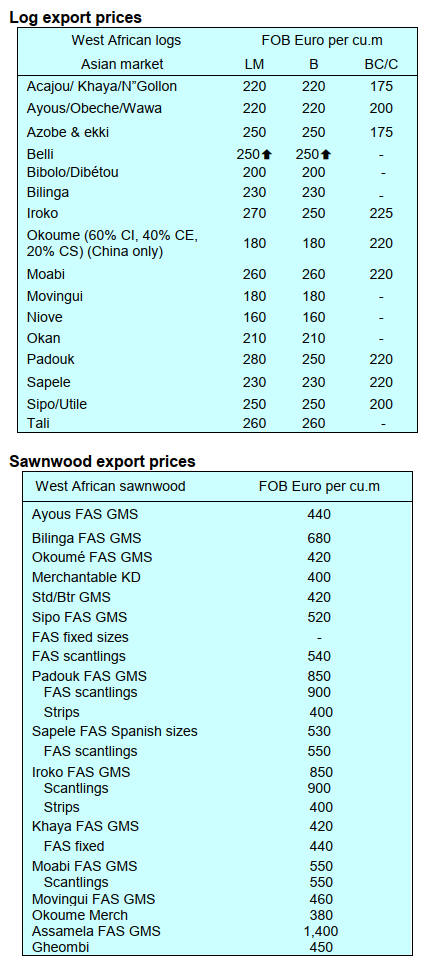
2.
GHANA
Participation in 5th World Teak Congress
Ghana participated in the 5th World Teak Congress
(WTC) which took place in Kochi, India, under the theme,
“Sustainable Development of the Global Teak Sector -
Adapting to Future Markets and Environments”.
The 4-day event was organised by TEAKNET, an
international network of institutions and individuals
interested in the teak value chain.
The mission of the Organisation is addressing the interests
of stakeholders which includes growers, traders,
researchers and other groups with an interest in teak. The
Conference brought together delegates from 40 countries.
Ghana was represented by a four-member delegation led
by the Chief Executive Officer (CEO) of the Ghana
Forestry Commission, Dr. Huge C. A. Brown, who is also
the Chairman of the Scientific Organising Committee and
Chairman of TEAKNET.
The Chairman of TEAKNET acknowledged the important
role the organisation has played in providing a platform
for all players in the teak sector to assemble at one place
for business and the exchange of ideas.
See: https://fcghana.org/5th-world-teak-congress-underway-in-kochi-india/
and
https://www.itto.int/top_stories/2025/09/24/5th_world_teak_conf
erence_experts_highlight_how_itto_project_is_advancing_sustainable_teak_production/
January to July exports
The total volume of wood products exported by Ghana
during the period January to July 2025 plummeted by 19%
to 126,980 cu.m. compared to the total volume of 157,518
cu.m. recorded for the same period in 2024 according to
data from the Timber Industry Development Division
(TIDD) of the Forestry Commission (FC).
These exports generated a revenue of Eur58.76 million an
18% decrease in value against the total receipts of
Eur71.27 million earned for the same period in 2024.
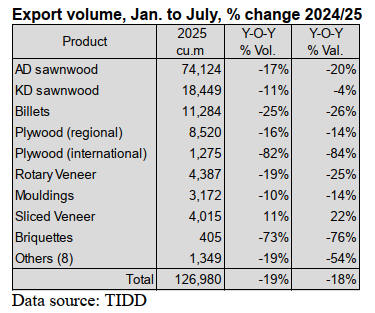
The top three products exported were air and kiln dried
sawnwood and billets accounting for 58%, 14% and 9%
respectively of the total export volume in 2025. The
dominance of air-dried sawnwood as against kiln-dried
sawnwood could be attributed to the high cost associated
with kiln-drying facilities.
The top destination for exports was the Asia which
accounted for 67% (84,951cu.m) of the country’s wood
products export for the period in January to July 2025,
compared to 65% (101,741 cu.m) of the total volume from
January to July 2024.
Revenue from wood products export to Asia accounted for
more than 50% of the total export receipts in 2024 (55%)
and in 2025 (55%), with the balances being from the
remaining five continental markets namely Europe,
America, Africa, Middle East and Oceania.
According to the data, air-dried sawnwood and billets
accounted for 99% of the total primary products exports
during the period January to July 2025.
Indian and Vietnamese companies were the major buyers
of the wood products with air-dried sawnwood (especially
wawa) and teak billets dominated exports to these two
countries.
Rivers and forests to be declared security zones
As part of renewed ongoing efforts to fight illegal mining
in the country, popularly known as galamsey, the Minister
for Lands and Natural Resources, Emmanuel Armah-Kofi
Buah, has announced government will soon declare all
rivers and forests in Ghana as security zones.
The move to designate rivers and forests as security zones
is expected to empower state security agencies to take
tougher action against illegal operations, which continue
to cause widespread destruction to water bodies and forest
reserves across the country.
Democracy Hub, the activist organisation behind Ghana’s
‘FixTheCountry’ movement, launched a major anti-
galamsey demonstration in the capital demanding
immediate government action against illegal mining
operations devastating the country’s water bodies and
forest reserves.
The demonstration represents the organisation’s latest
campaign following their successful mobilisation of
previous demonstrations aimed at convincing the
authorities to end the widespread environmental damage
and the socio-economic crisis caused by illegal mining
activities.
See: https://www.myjoyonline.com/rivers-forests-to-become-
security-zones-lands-minister-hints-in-intensified-galamsey-
fight/
Electricity tariff up by 1% more increases likely
The Public Utilities Regulatory Commission (PURC) has
announced a 1.14% upward adjustment in electricity
tariffs for all consumer categories effective 1 October
2025. Water tariffs remain unchanged.
In a statement signed by Acting PURC Executive
Secretary, Shafic Suleman, the Commission said the
decision follows its Quarterly Tariff Review Mechanism
which tracks key economic factors that affect the cost of
delivering utility services.
The Electricity Company of Ghana (ECG) is proposing a
more than doubling adjustment from the PURC in its
Distribution Service Charge (DSC1).
The company attributes the request to the depreciation of
the Ghana cedi effectively cutting ECG’s revenue in dollar
terms.
At a press conference the Director of Communications at
the IMF indicated that the IMF fully backs Ghana's efforts
aimed at reviewing utility tariffs in the country’s energy
and power sectors. The increase will also stimulate
investments to deal with the problems in the energy sector
See: https://ecg.com.gh/index.php/en/media-centre/public-notices/ecg-s-proposal-for-review-of-distribution-service-charge-1
Through the eyes of industry
The latest GTI report lists the challenges identified by the private sector
in Ghana.
https://www.itto-ggsc.org/static/upload/file/20250918/1758161706789480.pdf
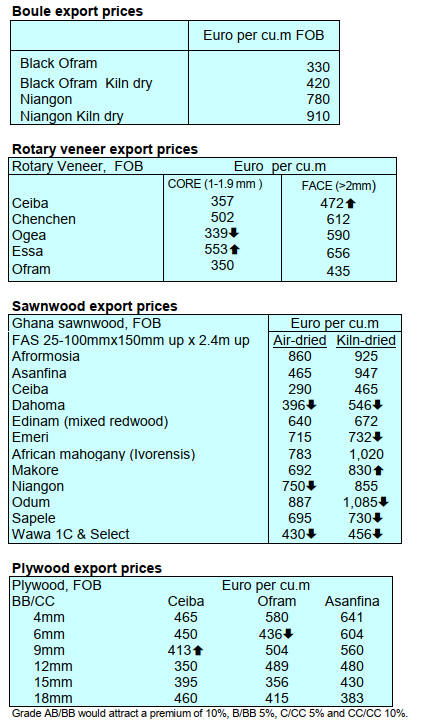
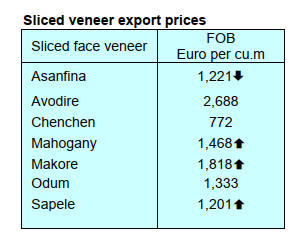
3. MALAYSIA
International Workshop on Indigenous Forestry
The Sarawak Dayak Iban Association (Sadia), an NGO, in
collaboration with Forest Stewardship Council (FSC)
Malaysia and FSC Indigenous Foundation (FSC-IF) held
an ‘International Workshop on Indigenous Forestry and
FSC Certification in Sarawak’.
Themed ‘Rooted in Responsibility: Strengthening
Indigenous Forestry Management and FSC Compliance,
the three-day programme brought together 25 participants,
including representatives of indigenous communities,
NGOs and FSC. The workshop combined traditional
knowledge sharing and dialogue on indigenous forest
governance.
International speakers and participants from Panama, the
Philippines, Indonesia and India were present to share with
the participants their diverse experiences. The workshop’s
final day highlighted FSC certification standards through a
participatory gap analysis, allowing communities to
compare their practices with FSC requirements and
identify next steps toward certification readiness.
Sadia president, Sidi Munan, is reported as saying “This
seminar shows that indigenous peoples are not only
guardians of the forests but also key actors in shaping
global sustainability standards”.
See:https://www.theborneopost.com/2025/09/19/sadia-forest-
stewardship-council-collaborates-in-workshop-on-indigenous-forestry-
global-standards-compliance/
Ecosystem Restoration
WWF Malaysia has been awarded the Ecosystem
Restoration Field Verification Certificate in recognition of
habitat restoration efforts within the Mount Wullersdorf–
Ulu Kalumpang Forest Reserves, carried out in
collaboration with the Sabah Forestry Department.
Developed by Preferred by Nature, this globally-
recognised standard evaluates on-the-ground restoration
efforts, ensuring compliance with best practices in
sustainability and environmental recovery.
Through targeted restoration efforts the site within the
Mount Wullersdorf–Ulu Kalumpang Forest Reserves is
helping to reconnect fragmented forest areas to rebuild
ecological connectivity.
These natural linkages are critical for the movement and
survival of endangered wildlife such as orangutans and
banteng (a species of wild cattle), allowing them to access
food sources, breeding grounds and safe migration routes.
Strengthening connectivity also supports broader
ecosystem functions, contributing to biodiversity
conservation and long-term climate resilience.
See:https://theborneopost.pressreader.com/article/281715505764244
Biomass plant
Construction has begun on a RM31 million biomass steam
plant in the Gebeng Industrial Estate signaling a major
step in Malaysia’s renewable energy and de-carbonisation
agenda.
The plant will supply up to 30 tonnes per hour (TPH) of
biomass-generated steam to Kaneka Malaysia, replacing
natural gas-based systems. Kaneka Malaysia is targeting a
70% reduction in greenhouse gas emissions by 2030
aligned with its net zero 2050 goal.
Fuelled by palm-based biomass such as empty fruit
bunches, palm kernel shells and woodchips the facility
features high thermal efficiency systems automated ash
handling and stringent emissions controls.
The project supports the national Renewable Energy
Roadmap and National Energy Transition Roadmap by
promoting circular economy principles and converting
agricultural waste into clean energy.
See:https://theedgemalaysia.com/node/770192
Mangrove forest maintenance
Malaysia allocated over RM71 million for the planting and
maintenance of mangrove trees and suitable species
nationwide from 2006 to date. The Ministry for Natural
Resources and Environmental Sustainability said the
allocation covers research and development, monitoring
activities and public awareness programmes.
As of September this year, 3,820 hectares of coastal and
mangrove forest areas have been planted with over nine
million mangrove trees and other suitable species along
the country’s coastline. This work is supported by more
than 120 research studies that serve as key references,
along with the active involvement of 13 non-government
organisations and local communities.
This was revealed during the National Celebration of the
International Day for the Conservation of the Mangrove
Ecosystem and National Social Forestry Carnival 2025.
See: https://theborneopost.pressreader.com/article/281621016497736
Through the eyes of industry
The latest GTI report lists the challenges identified by the
private sector in Malaysia.
https://www.itto-ggsc.org/static/upload/file/20250918/1758161706789480.pdf
4.
INDONESIA
Deregulation team to eliminate export and
investment barriers
According to Coordinating Minister for Economic Affairs,
Airlangga Hartarto, Indonesia's furniture industry is
gaining momentum as a potential key export driver
supported by the country’s rich natural resources and
strong creative design capabilities.
To further enhance its international presence the
government is pursuing strategic trade agreements,
including the upcoming Comprehensive Economic
Partnership Agreement (CEPA) with the European Union
which will grant zero-tariff access for up to 80% of
Indonesian products, including furniture.
Domestically, the government is implementing a range of
supportive policies aimed at boosting production and
workforce efficiency. These policies include subsidised
investment loans through the People’s Business Credit
(KUR) scheme, tax relief for low-income workers and
fully funded internship programmes for university
graduates.
Also, a cross-sector deregulation team will begin work in
October 2025 to eliminate export and investment barriers.
Through these integrated efforts, the government envisions
the furniture industry becoming a cornerstone of
Indonesia’s economic growth and a strong competitor in
global markets.
See: https://wartaekonomi.co.id/read583133/industri-furnitur-
berpotensi-jadi-penopang-utama-ekspor-ri
Showcasing eco-friendly wooden and rattan furniture
At the Korea International Furniture and Interior Fair
(KOFURN) 2025, Indonesian furniture businesses secured
potential transactions totaling US$3.07 million according
to Indonesia’s Ministry of Trade. Twelve Indonesian
exporters participated in the event showcasing eco-
friendly wooden and rattan furniture that blends traditional
craftsmanship with minimalist aesthetics.
The Ministry of Trade aims to further boost exports by
leveraging the Indonesia-Korea Comprehensive Economic
Partnership Agreement (CEPA) which offers zero tariffs
on furniture products. Officials see strong future potential
in the South Korean market due to its high purchasing
power and alignment with current design trends.
See: https://en.antaranews.com/news/379865/indonesias-
furniture-exports-to-south-korea-reach-usd307-mln
Creativity becoming engine of economic growth
The International Furniture and Craft Fair Indonesia
(IFFINA+) 2025, held at the Indonesia Convention
Exhibition BSD in Tangerang, showcased the country’s
growing recognition on the global stage for its creative
industries, particularly furniture and crafts.
With the theme “Story of Origin,” the exhibition
highlighted over 150 brands and 25 designers from across
Indonesia. It emphasised the nation's commitment to
offering unique designs featuring storytelling and
functionality that add value. The event acted as a strategic
bridge between local creators and international buyers,
aiming to expand Indonesia’s global presence in the
creative economy.
During the opening ceremony, Deputy Minister of
Creative Economy, Irene Umar, stressed the importance of
cross-sector collaboration in building a strong, sustainable
creative ecosystem. She underlined that, on a global scale,
creativity is becoming a new engine of economic growth
in both the national and international markets. IFFINA+
thus served as a symbol of Indonesia's bold steps towards
globalising its creative industry through innovation and
cultural identity.
See: https://rri.co.id/en/business/1841395/iffina-supports-
indonesia-s-furniture-going-global
Timber plantations for renewable energy
The Ministry of Forestry has announced its support for the
development of industrial timber plantations as a key
strategy to boost renewable energy production, restore
degraded ecosystems and strengthen the country’s climate
change mitigation efforts.
According to Tony Rianto, Head of the Sub-Directorate of
Forest Product Certification and Marketing, sustainably
managed timber plantations are seen as a vital solution for
rehabilitating critical lands, providing biomass energy and
achieving Indonesia’s 2030 Forestry and Other Land Use
(FOLU) Net Sink target, which aims to absorb more
carbon emissions than are released.
In addition to environmental goals, the government sees
plantation development as an opportunity to drive
economic benefits at the local level. These include job
creation, increased regional investment, diversification of
energy sources and enhanced global competitiveness
especially in the wood pellet export market.
Acknowledging concerns from civil society about the
biomass industry’s potential risks, the ministry has
implemented strict regulations and monitoring systems
such as mandatory sustainability certification (SVLK),
technology-based oversight and law enforcement to ensure
plantation development aligns with environmental and
social sustainability standards.
See:
https://money.kompas.com/read/2025/09/17/203049426/hutan-
tanaman-industri-untuk-biomassa-diklaim-dukung-energi-terbarukan?page=all#page2.
Indonesia to speed up recognition of indigenous forests
Indonesia is taking steps to accelerate the legal recognition
of indigenous forests with the government aiming to
formalise at least 70,000 hectares by the end of 2025. The
Minister of Forestry, Raja Juli Antoni, announced that a
newly formed Task Force for the Acceleration of
Customary Forest Designation has been created to tackle
bureaucratic delays that have hindered progress for years.
Since 2016, around 332,000 hectares have been recognised
as customary forests but at least 1.4 million hectares are
still awaiting legal status. The government hopes the Task
Force will identify obstacles and establish more efficient
processes to speed up recognition efforts moving forward.
The Task Force will adopt an inclusive and collaborative
approach, involving not only government officials but also
academics, environmental activists and civil society
organisations.
Experts from Gadjah Mada University, Bandung Institute
of Technology and Cenderawasih University are working
alongside advocacy groups such as the Indonesian Forum
for the Environment (Walhi) and the Indigenous Peoples'
Alliance of the Archipelago (AMAN). Minister Antoni
emphasised that this joint effort aims to create long-term
solutions and ensure that the rights of indigenous
communities over their ancestral lands are properly
acknowledged and protected.
See:https://en.antaranews.com/news/380809/indonesia-to-speed-up-recognition-of-indigenous-forests
and
https://www.liputan6.com/news/read/6159625/menhut-bentuk-
tim-percepatan-penetapan-hutan-adat-diisi-akademisi-hingga-lsm
Developing zoning map for mangrove rehabilitation
The Ministry of Environment is developing a detailed
zoning map to guide the rehabilitation of 600,000 hectares
of mangrove forests by 2029. The initiative aims to
strengthen coastal resilience and protect biodiversity by
targeting both forest and non-forest areas. This large-scale
effort involves collaboration between government
agencies, private sector stakeholders and local
communities to ensure the long-term sustainability of
mangrove ecosystems.
According to Sigit Reliantoro, Deputy for Environment
and Sustainable Natural Resources at the Ministry’s
Environmental Control Agency (BPLH), the zoning map
will categorise areas based on their environmental
suitability for mangrove planting.
See: https://rri.co.id/en/national/1843648/indonesia-develops-
zoning-map-for-mangrove-rehabilitation
In related news, Asia Pulp & Paper (APP) Group has
reportedly launched a new sustainability initiative called
Regenesis, pledging US$30 million annually for the next
decade to restore and conserve one million hectares of
Indonesia’s rainforests.
This commitment aims to go beyond traditional
conservation efforts by actively restoring ecosystems,
supporting local communities and driving innovation
across the company’s operations.
As part of the Regenesis initiative the APP Group also
introduced a new Forest Positive Policy which strengthens
its 2013 Forest Conservation Policy with a more structured
and ambitious sustainability framework.
The policy, says APP, is built on three core pillars: forests,
people and value chain. It focuses on achieving positive
ecological impact through integrated landscape
management, empowering communities through inclusive
development strategies and ensuring responsible sourcing
and supplier practices to create shared value.
See: https://www.businesstimes.com.sg/esg/app-group-pledges-
us30-million-year-restore-1-million-hectares-indonesias-
rainforests
IEU-CEPA opens trade cooperation opportunities
The Indonesia-European Union Comprehensive Economic
Partnership Agreement (IEU-CEPA), finalised after nine
years of negotiation, marks a major milestone in
Indonesia's economic diplomacy. According to the
Coordinating Ministry for Economic Affairs, this
agreement lays the groundwork for a more inclusive, fair
and sustainable trade relationship between Indonesia and
the EU.
The IEU-CEPA is expected to significantly improve
market access, boost foreign investment and strengthen the
competitiveness of key sectors in Indonesia. With the EU
being Indonesia’s fifth-largest trading partner the
partnership holds substantial economic potential. In 2024,
the trade volume between the two reached US$30.1 billion
with Indonesia enjoying a growing trade surplus rising
from US$2.5 billion in 2023 to US$4.5 billion in 2024.
The agreement is thus seen as a vital step toward
deepening economic ties and promoting long-term mutual
benefits.
Indonesia and the European Union officially signed the
substantial conclusion of the Indonesia-European Union
Comprehensive Economic Partnership Agreement (IEU-
CEPA) on September 23, 2025. The agreement, signed by
Indonesia’s Coordinating Minister for Economic Affairs
Airlangga Hartarto and European Commission’s
Commissioner for Trade and Economic Security Maroš
Šefčovič, marks a significant milestone after nearly a
decade of negotiations.
See: https://en.antaranews.com/news/381676/ieu-cepa-opens-up-fair-trade-cooperation-opportunities-ministry
and
https://www.cnbcindonesia.com/news/20250923104236-4-669334/sah-ri-uni-eropa-teken-dokumen-substansial-ieu-cepa
Through the eyes of industry
The latest GTI report lists the challenges identified by the private sector
in Indonesia.
https://www.itto-ggsc.org/static/upload/file/20250918/1758161706789480.pdf
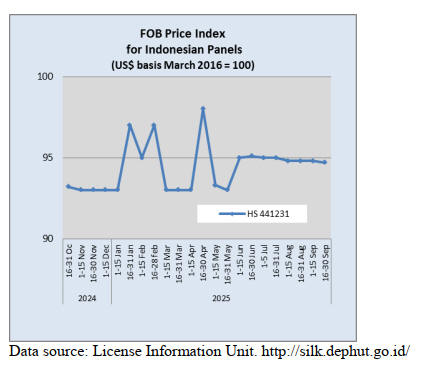
5.
MYANMAR
Foreign investment declines sharply
Foreign direct investment (FDI) in Myanmar dropped
sharply in the first five months of the 2025–26 fiscal year
to just US$129 million compared with more than US$200
million in the same period last year.
The bulk of new inflows went into manufacturing (US$93
million), followed by oil and gas, energy and services.
Singapore remained the largest investor at US$36 million
with China at US$33 million and Thailand at about US$32
million.
China has become a key target for the Myanmar authority
and senior leaders recently met Chinese business
executives in Beijing pledging to protect investors and
proposing the creation of a Myanmar–China business
cooperation association.
See - https://burmese.dvb.no/post/724546
Addressing the energy crisis
Myanmar’s power sector is in crisis with demand
averaging 4,400 megawatts daily against production of
less than 2,000 megawatts. More than half the population
lacks reliable electricity while industries and major cities
face frequent blackouts. The World Bank has warned that
the challenges are structural and tied to conflict, political
instability and fragile infrastructure.
A World Bank study says Myanmar is endowed with
abundant primary energy resources. Its hydropower
potential is estimated at more than 100,000 megawatts
(MW) in its river systems including four basins of
Ayeyarwady, Chindwin, Thanlwin and Sittaung.
The installed hydropower capacity, however, is only 3,262
MW (2023), illustrating the huge potential to be harnessed
that could, in the long term, not only meet domestic
demand but also become a green energy source for the
region.
Myanmar is also a hydrocarbon-rich country; the potential
reserves of crude oil, natural gas, and coal are 15,220
million barrels, 93.698 trillion cubic feet, and 711 million
metric tons, respectively, according to the official
statistics.
Proven oil reserves are estimated at 50 million barrels,
and gas reserves at around 10 trillion cubic feet.
Conditions for renewable energy are favorable too.
Myanmar is in the “sunbelt” with the highest solar
potential reaching 6.6 kilowatt-hours per square meter
(kWh/m²) per day on a horizontal surface in the dry zone
(Mandalay, Sagaing, and Magway regions). Myanmar thus
has greater energy generation potential and more options
for meeting its needs than most countries in the region.
Myanmar is reportedly seeking to develop a nuclear
energy programme in partnership with Russia as it seeks to
address chronic electricity shortages.
Reports suggest Myanmar has signed an agreement with
the Russian state corporation for nuclear energy (Rosatom)
to build a small modular nuclear plant. No site or firm
timeline disclosed; financing structure also not disclosed.
See:
https://documents1.worldbank.org/curated/en/099062324221019
838/pdf/P500473-48b24a55-b69d-481b-9ce3-dee0cba378ed.pdf
and
https://www.bernama.com/en/world/news.php?id=2471748
ASEAN calls for easing border tensions
ASEAN has renewed its call for Myanmar to fully
implement the Five-Point Consensus and backed the
bloc’s Special Envoy to foster dialogue among
stakeholders but progress remains stalled as the country’s
political crisis deepens.
Tensions have sharpened ahead of a planned general
election later this year. A diplomatic mission by Foreign
Mnisters from Malaysia, Thailand, Indonesia and the
Philippines intended to assess the post-emergency
situation was postponed. ASEAN has urged that peace
and stability take precedence over elections.
See - https://www.scmp.com/week-
asia/politics/article/3326361/aseans-failure-meet-myanmar-junta-
over-election-shows-its-limited-leverage?utm_source=chatgpt.com
6.
INDIA
Sawnwood price index up, veneer index down
The annual rate of inflation based on the all India
Wholesale Price Index (WPI) was 0.52% in August. The
positive rate of inflation in August 2025 was primarily due
to increases in prices of food products, other
manufacturing, non-food articles, other non-metallic
mineral products and other transport equipment.
The index for manufacturing increased from 144.6 in July
to 144.9 in August. Out of the 22 NIC two-digit groups for
manufactured products 13 groups witnessed price
increases, 5 groups a decrease and 4 groups saw no
change.
Some of the groups that showed month on month price
increases were manufacture of food products, textiles,
electrical equipment, other transport equipment and
machinery and equipment. Some of the groups that saw a
decrease in price were manufacture of basic metals,
computers, electronic and optical products, wearing
apparel, products of wood and cork along with furniture.
The price index for wood panels in August was unchanged
from July. The sawnwood price index recoverd in August
but there was a downward correction in the index for
veneers.
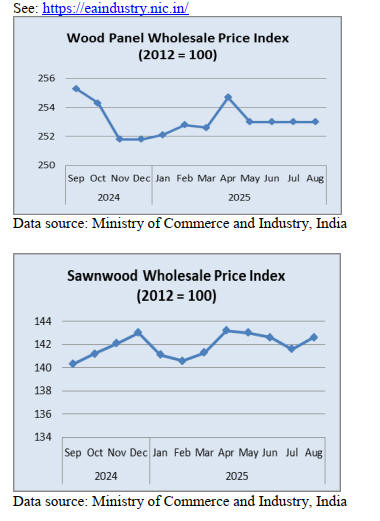

Lower GST will boost the economy
The new dual-slab goods and services tax (GST) structure
adopts a next-generation approach to dealing with indirect
taxation and will boost the economy significantly
according to Union Minister of Finance, Nirmala
Sitharaman. The new GST structure that takes effect
September 22 will have two rates 5% and 18%. Selected
luxury goods will be taxed at 40%.
She added the government is preparing a package for US
tariff-affected export sectors and a new wave of policy
changes is being worked on as the government realised the
need to diversify the economy in view of recent
challenges.
India’s economy grew by a better-than-expected, five-
quarter high of 7.8% in the June quarter but faces
headwinds from higher US tariffs.
See:
https://economictimes.indiatimes.com/news/economy/policy/low
er-gst-will-boost-indias-economy-higher-says-fm-nirmala-
sitharaman/articleshow/123728556.cms?from=mdr
Tripura can be leading plywood producer
As a result of infrastructure developments in Tripura,
backed by an Asian Development Bank, the Tripura
Industrial Development Corporation (TIDC) has initiated a
project to promote the plywood industry in the State.
Nabadal Banik, TIDC Chairman, said currently there are
two plywood plants in the State with another seven under
development.
The State has around 110,000 hectares of rubber plantation
of which approximately 10,000 hectares are ready for
replanting. If the plywood development initiative succeeds
Tripura will be one of the leading States in plywood
manufacturing, asserted Banik.
In addition to industrial development, the emphasis on
rubberwood plantations will also serve the State’s mission
to raise farmers’ income through agro-forestry.
See: https://www.newsonprojects.com/news/adb-approves-975-
crore-loan-to-boost-tripuras-industrial-infrastructure
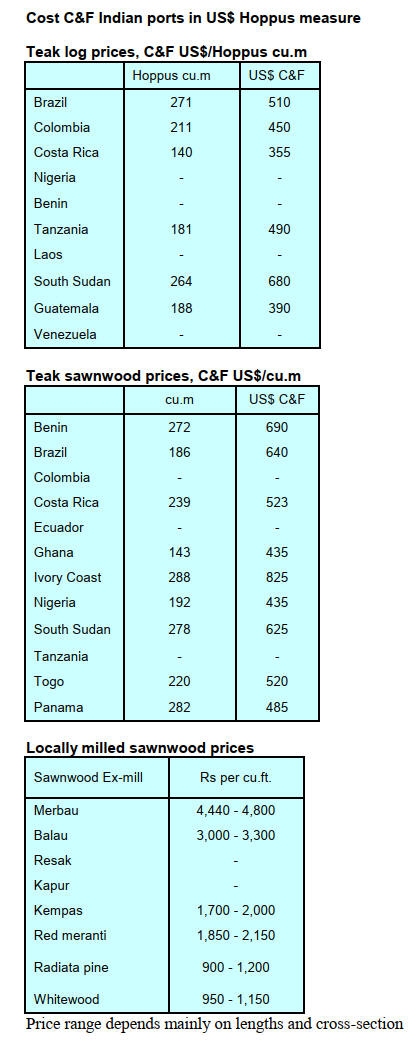
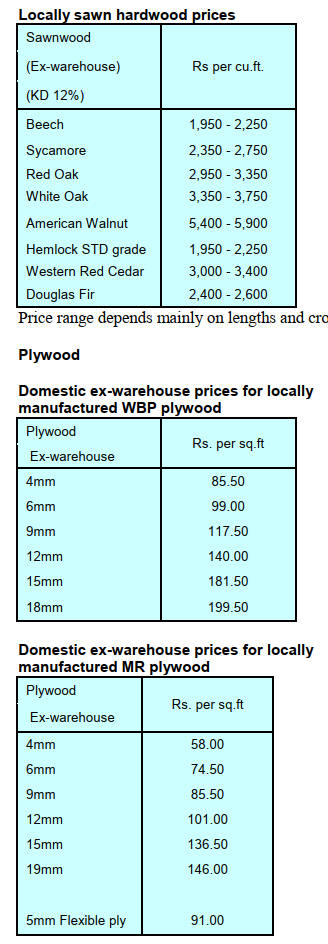
7.
VIETNAM
Wood and Wood Product (W&WP) trade highlights
According to statistics from the Viet Nam Customs
Department W&WP exports in August 2025 reached
US$1.46 billion, down 0.5% compared to July 2025 and
down 3% compared to August 2024. Of the total WP
exports were valued at US$970 million, down 3.5%
compared to July 2025 and down 7% compared to August
2024.
In the first 8 months of 2025 W&WP exports totalled
US$11.1 billion, up 6.5% over the same period in 2024 of
which WP exports alone accounted for US$7.6 billion, up
6% over the same period in 2024.
W&WP exports to the EU market in August 2025 earned
US$51.5 million, up 52% compared to August 2024. In
the first 8 months of 2025 W&WP exports to the EU
amounted to US$400 million, up 15% over the same
period in 2024.
Office furniture exports in August 2025 contributed
US$33 million to total earnings, up 0.3% compared to
August 2024. In the first 8 months of 2025 exports of
office furniture brought in about US$252 million, up 31%
over the same period in 2024.
W&WP imports into Viet Nam in August 2025 reached
US$288.5 million, down 7% compared to July 2025, but
up 6% compared to August 2024. In the first 8 months of
2025 W&WP imports were valued at US$2.11 billion, up
17% over the same period in 2024.
Ash wood imports in August 2025 were estimated at
87,100 cu.m, worth US$23.8 million, down 8% in volume
and 7% in value compared to July 2025 but compared to
August 2024 imports were up 20% in volume and 37% in
value. In the first 8 months of 2025 ash wood imports
totalled 560,500 cu.m, worth US$147.7 million, up 48% in
volume and 51% in value over the same period in 2024.
Viet Nam’s imports of raw wood (logs and sawnwood)
from the US in July 2025 reached 158,390 cu.m, with a
value of US$67.13 million, down 8% in volume and 9% in
value compared to June 2025 but up 115% in volume and
118% in value over the same period in 2024. In the first 7
months of 2025 imports of raw wood from the US reached
749,250 cu.m with a value of US$311.49 million, up 90%
in volume and 85% in value over the same period in 2024.
Woodchip exports in August 2025 reached US$195
million, down 29% compared to August 2024. In the first
8 months of 2025 wood chip exports are estimated at
US$1.6 billion, down 11% over the same period in 2024.
Domestic market a strategic pillar for industry
Vu Ba Phu, Director of the Trade Promotion Agency,
Ministry of Industry and Trade, has said besides exports
the domestic market of more than 100 million people
needs to be considered a strategic pillar to ensure stable
and sustainable growth for the wood industry.
Viet Nam's wood industry has made great strides,
becoming a leading center for processing and supplying
wooden furniture and interiors. In 2024 exports of wood
and wood products reached US$16.28 billion, up 21%
over the previous year.
In the first 8 months of 2025 exports reached US$11.1
billion, up 6% over the same period last year and the
whole year is expected to reach US$18 billion.
These figures show strong resilience but also reflect a
large dependence on external markets.
Vu Ba Phu has repeatedly emphasised “The wood and
forestry industry has always been considered one of the
important industries in Viet Nam, not only contributing
greatly to exports but also affirming its position on the
global trade map. However, businesses need to pay special
attention to exploiting the potential of the domestic market
with more than 100 million people, where purchasing
power is increasing strongly”.
As expected, the domestic market is the fulcrum for the
wood industry to maintain its growth rate in the context of
many international fluctuations. The rapid increase in
housing demand, urbanisation and green consumption
trends have created a large development space for
domestic wooden furniture products. If exploited this will
be the driving force to help the industry reduce the risk of
depending on large markets such as the US or EU.
From an association perspective Ngo Sy Hoai, Vice
President and General Director of the Viet Nam Timber
and Forest Products Association, also pointed out “Viet
Nam's wood industry currently exports to more than 40
markets and imports raw materials from more than 100
markets. However, we cannot only focus on exports. With
the characteristics of wood products closely related to the
environment and forests the domestic market will be the
place to affirm the responsible and sustainable
development of the industry.”
Trade promotion - key to exploiting market potential
Trade promotion plays a central role in developing both
international and domestic markets. Major fairs such as
Hawa Expo, VIFA ASEAN or VIFA Expo are not only
places to display and promote Viet Namese wood products
to the world but also an opportunity for businesses to
reach domestic consumers.
Vu Ba Phu affirmed “Towards the target of wood and
wood products exports reaching over US$18 billion in
2025 the Ministry of Industry and Trade will continue to
closely coordinate with ministries, branches and localities
to implement many programmes to support businesses in
technology transformation, design improvement, brand
development and trade promotion. The domestic market
must also be placed at the center of this strategy.”
According to him, in addition to organising fairs the
industry needs to expand specialised trade promotion
services, researching domestic consumer tastes, organising
communication campaigns, training on design, e-
commerce and green transformation. This will not only
help increase exports but also effectively stimulate
domestic purchasing power.
Representing the wood industry business community, Ngo
Sy Hoai suggested that foreign and domestic media
channels support strong promotion of the wood industry's
achievements, spreading the message that Viet Nam is
determined to develop a responsible and sustainable wood
industry. Linking the Viet Namese wood brand with the
image of green, environmentally friendly production will
create a competitive advantage right at home.
In order for the domestic market to truly become a fulcrum
experts also recommend solutions that need to be
implemented synchronously. In particular, by researching
consumer tastes and trends businesses need to:
+ grasp changes in design needs, materials and
models especially with the young generation who
make up a large proportion of the population.
+ develop diverse distribution channels, combining
traditional stores, furniture supermarkets, and e-
commerce platforms.
+ apply virtual reality technology and online
shopping experiences.
+ strengthen domestic trade promotion, promote the
organisation of specialised fairs and exhibitions
in major cities such as Hanoi, Ho Chi Minh City,
Da Nang and expand to localities with high
demand for construction and urbanisation.
Viet Nam’s wood industry has risen fast thanks to the
strength of exports. But to maintain growth momentum
and minimise risks the domestic market needs to be seen
as a “second pillar” alongside the international one.
With more than 100 million people the domestic market is
not only a place for consumption but also a “laboratory”
for businesses to test designs, shape trends and build
sustainable brands.
As Vu Ba Phu emphasised, the sustainable development of
the wood industry cannot rely solely on exports but must
also rely on the growth of the domestic market. And as
Ngo Sy Hoai affirmed, Viet Namese wood must follow a
responsible path, associated with the environment to
thereby affirm its value domestically before reaching out
to the world.
See: https://www.Viet Nam.vn/en/mo-rong-thi-truong-trong-nuoc-cho-nganh-go-viet
Viet Nam and Germany outline next steps for sustainable timber trade
On September 11-12, the Viet Nam Forestry
Administration (VNFOREST) and the German
Development Agency (GIZ) hosted a forum titled
"Ensuring Timber Legality for Sustainable Forestry
Development in Viet Nam". The event served as a crucial
platform to strengthen joint efforts on timber traceability
and legality, review the country's progress towards
implementing the Voluntary Partnership Agreement on
Forest Law Enforcement, Governance and Trade (VPA
FLEGT), and promote gender equality within the forestry
sector.
At the opening of the forum, Director General Tran Quang
Bao remarked, “This forum provides an important
opportunity for government agencies, businesses, timber
associations, social organisations, local communities and
international partners to exchange views, share
experiences and propose solutions to ensure the legality of
timber in Viet Nam.
We especially appreciate the support of the German
people and government through the GIZ, in implementing
the VPA FLEGT, a strong example of multistakeholder
cooperation and our shared commitment to building a
timber industry that is legal, transparent, sustainabl, and
responsible.”
Jens Schmid-Kreye, the First Secretary at the German
Embassy said Germany is proud to support Viet Nam in
strengthening timber legality and sustainable forestry
through our joint technical cooperation to develop
enabling policy frameworks, capacity development and
knowledge transfer and the development of practical
digital tools.”
Meanwhile, the EU and Viet Nam share a strong,
cooperative relationship, particularly in trade, highlighted
by the free trade agreement that entered force in 2020.
See: https://vir.com.vn/Viet Nam-and-germany-outline-next-
steps-for-sustainable-timber-trade-136319.html
Wood chip exports declined in first 8 months 2025
It is estimated that the exports of woodchips in August
2025 reached US$195 million, down 29% compared to
August 2024. In the first 8 months of 2025, woodchip
exports earned US$1.6 billion, down 11% over the same
period in 2024.
The main market was China at US$891.4 million but
down 13% over the same period in 2024. This is a sharp
decline, reflecting the slowdown in demand for pulp and
paper materials in China.
Exports to Japan, as the next destination, reached
US$349.3 million, up 3% followed by Indonesia
(US$101.1 million, up 3%), South Korea (US$37.9
million, up 7%).
A decline in key markets such as China and South Korea
poses a challenge for Viet Namese wood chip enterprises
and the need to reassess their export strategies.
Of significance is the strengthened cooperation with forest
farms and plantations to ensure stable supply, consistent
quality and reduced logistics costs. Optimising production
processes associated with reducing carbon emissions to
meet increasing demand from the buyers, has been
emerging as a priority.
8. BRAZIL
Bahia State boosting the production Chain and
sustainability
The city of Salvador in the State of Bahia will host the 5th
“Sustainable Timber: The Future of the Market”, on 19
November 2025. The event is being organised by the
National Forum of Forest-Based Activities (FNBF) in
partnership with the Center of Timber Producing and
Exporting Industries of the State of Mato Grosso (Cipem)
with support from Sebrae Mato Grosso, Sebrae Bahia and
the Industrial Federations of Mato Grosso State (Fiemt)
and the Bahia State (Fieb).
The conference will bring together public sector
representatives, business leaders and experts to discuss
opportunities and challenges in the native timber
production chain with a focus on legality, sustainability
and innovation.
The conference in the Northeast region is strategic
considering the concentration of consumer hubs and the
increasing demand for sustainable solutions. The event
seeks to strengthen the perception of legally sourced
timber as a tool for decarbonising the civil construction
sector, generating jobs and income and fostering the socio-
economic development of forest regions. It seeks to
consolidate its position as a platform for business
development, sectoral integration and the promotion of the
Brazilian forest industry.
See: https://www.folhamax.com/mobile/economia/madeira-
sustentavel-chega-a-salvador/512056
Mato Grosso’s forest sector in crisis
The forest sector in the State of Mato Grosso is facing a
severe crisis as a result of tariffs imposed by the United
States on Brazilian wood products with the impact being
felt in the Ipe flooring and decking sector where the main
market is the US.
The tariffs have affected sales which led to reduced shifts,
production cuts and mass layoffs affecting companies that
had been operating exclusively in this niche market for
years. The inability of importers to pass on the costs of the
tariffs to consumers coupled with the difficulty of
directing production to other markets has led to high
stocks levels, falling prices and an erosion of the sector’s
competitiveness. Together, the tariffs are causing negative
economic effects throughout the entire regional supply
chain.
In response, associations and federations in the timber
sector requested the Federal Government to take strong
position in negotiations with the US government. At the
same time, companies are exploring mitigation strategies
such as diversifying timber species and identifying new
consumer markets with the aim of preserving economic
viability and minimising the impact on employment and
production.
See: https://nativanews.com.br/economia/setor-florestal-de-mato-
grosso-entra-em-crise-apos-tarifas-dos-eua-sobre-madeira-de-
ipe/
Export update
In August 2025 Brazilian exports of wood-based products
(except pulp and paper) decreased 18% in value compared
to August 2024, from US$268.4 million to US$220.5
million.
Pine sawnwood exports decreased 12% in value between
August 2024 (US$48.2 million) and August 2025
(US$42.6 million). In volume, exports decreased 7% over
the same period from 205,700 cu.m to 191,100 cu.m.
In contrast, tropical sawnwood exports in August 2025
increased 26% in volume, from 17,600 cu.m in August
2024 to 22,100 cu.m. In value, exports increased 34%
from US$6.5 million to US$8.7 million over the same
period.
Pine plywood exports decreased 27% in value in August
2025 compared to August 2024 from US$58.7 million to
US$42.8 million. In volume, exports decreased 21% over
the same period, from 173,600 cu.m to 136,700 cu.m.
As for tropical plywood, exports increased in volume by
87% and by 67% in value from 1,500 cu.m and US$0.9
million in August 2024 to 2,800 cu.m and US$1.5 million
in August 2025.
Wooden furniture exports decreased from US$48.4 million
in August 2024 to US$44.6 million in August 2025, a
decrease of 8%.
US tariff impacts the timber sector
The Brazilian Association of Mechanically Processed
Timber Industry (ABIMCI) has reported significant
impacts on the Brazilian timber sector from the 50% tariff
imposed by the United States.
A survey conducted with its member companies recorded
approximately 4,000 layoffs between July and September.
In addition 5,500 workers were placed on vacation and
1,100 under temporary layoff arrangements.
If the current tariff scenario remains unchanged it is
estimated that as many as 4,500 more jobs will be lost
over the next 60 days compromising socio-economic
sustainability.
The tariff increase caused an immediate downturn in the
market leading to contract cancellations, shipment
interruptions and a significant reduction of new business
deals. August export data indicates a decline of between
35% and 50% in the volume of wood products shipped to
the US.
ABIMCI has sought dialogue with the Ministry of
Development, Industry and Trade (MDIC), requesting the
initiation of diplomatic negotiations with the US
government based on technical and commercial grounds to
seek tariff readjustment.
The Association points out that the sector accounts for
about 50% of Brazil’s export-oriented production (in some
segments, with up to 100% dependency on the US market)
and emphasised that the timber sector generated US$1.6
billion in export revenues in 2024.
The Association warns that the continuation of the current
tariffs puts at risk around 180,000 formal jobs, disrupts
well-established production chains and threatens decades
of investments in technology, certification and compliance
with international market requirements.
ABIMCI considers the urgent need for the federal
government to take immediate action to re-establish
bilateral trade and mitigate the economic and social
impacts on the sector.
In related news, in early September ABIMCI participated
in a high-level business mission to Washington organised
by the National Confederation of Industry (CNI) with the
participation of sectoral associations and industry
federations. The initiative focused discussions with US
authorities and institutions on mitigating the impact of
tariffs imposed on Brazilian products and to safeguard the
competitiveness of bilateral trade.
The mission’s agenda included strategic meetings at the
Brazilian Embassy, dialogues with the US Chamber of
Commerce and legal consultancies specialised in
government relations seeking negotiated pathways for the
reversal of tariff barriers.
ABIMCI participated in a public hearing convened by the
United States Trade Representative (USTR) under Section
301 of the US Trade Act and presented a technical defense
of Brazil’s processed wood industry.
ABIMCI’s formal submission filed on 18 August
highlighted the sustainable origin of exported timber
products, strict compliance with Brazilian environmental
and labour legislation and the absence of forced labour
within the sector.
The document emphasised traceability systems, forest
certification and the sector’s commitment to combating
illegal deforestation and this was supported by letters of
endorsement from US importers.
This mission consolidated a coordinated, multisectoral
action to sustain trade flows and align diplomatic efforts,
prioritising technical approaches and defending the
international image of the Brazilian forestry sector.
See: https://bit.ly/PosicionamentoAbimciTaxaçãoEUA and
https://abimci.com.br/abimci-participa-de-missao-empresarial-a-washington/
and
https://abimci.com.br/abimci-estara-em-audiencia-publica-no-
istr-dia-3-09-sobre-a-investigacao-da-secao-301/
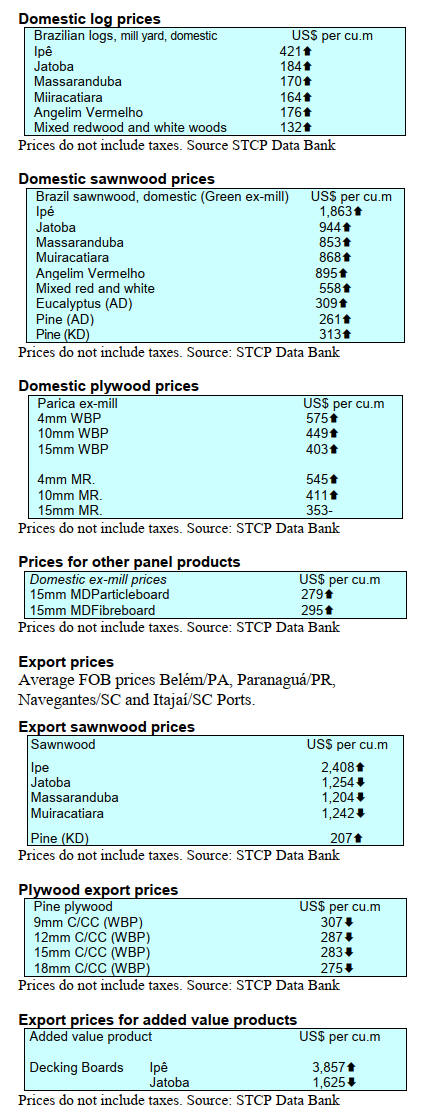
Through the eyes of industry
The latest GTI report lists the challenges identified by the private sector
in Brazil.
https://www.itto-ggsc.org/static/upload/file/20250918/1758161706789480.pdf
9. PERU
Export update - July
Shipments of wood products totalled US$37.4 million
during the first five months of 2025 representing a
decrease of 21% compared to the same month in 2024
(US$47.4 million) according to the Center for Global
Economy and Business Research of the CIEN-ADEX
Exporters Association.
According to figures from the ADEX Data Trade Trade
Intelligence System exports included sawnwood
(US$14.3 million), semi-manufactured products (US$11.7
million), firewood and charcoal (US$3.8 million),
furniture and parts (US$2.5 million) and construction
products (US$2.3 million).
The leading destination was the Dominican Republic with
shipments totalling US$7.3 million, an increase of 13%
compared to the previous year. The US followed with
US$5.6 million, a massive decline compared to 2024,
France with US$4.8 million, a decrease of 37%, Mexico
with US$3.8 million, a decrease of 27% and rounding out
the top 5 markets was Viet Nam with exports at US$3.7
million, an increase of 32%.
Veneer and plywood exports continue to grow
According to information provided by the Extractive
Industries and Services Department of the Association of
Exporters (ADEX) veneer and plywood shipments during
the January-July 2025 period reached an FOB export value
of US$1.5 million growing by 7%, a positive change
compared to the same period in 2024 (US$1.4 million),
The main market for exports in this subsector was Mexico
which represented a 47% share but this was much lower
than in the same period in 2024. Ecuador had a 32% share
and Colombia at an 11% share followed by the Dominican
Republic (6% share) and Costa Rica with a 3% share.
SERFOR and Germany alliance to promote SFM
The National Forestry and Wildlife Service (SERFOR)
and the German Development Bank (KfW) have
successfully completed a mission on the Sustainable
Productive Forests Programme (BPS). Following the visit
key agreements to further strengthen forest development,
sustainable management and the fight against
deforestation were made.
During the mission, conducted between September 2 and 9
in Lima and Madre de Dios, both institutions highlighted
the progress of the Sustainable Productive Forests
Programme (BPS) and agreed on new actions to accelerate
its implementation.
Among the main agreements reached was a decision to
expand access to financing to support investments in
plantations, natural forest management and forest planning
and to evaluate the expansion of the Forest Incentives
Programme.
See: https://www.gob.pe/institucion/serfor/noticias/1246936-
serfor-y-gobierno-aleman-fortalecen-alianza-para-impulsar-la-
gestion-forestal-sostenible-en-peru
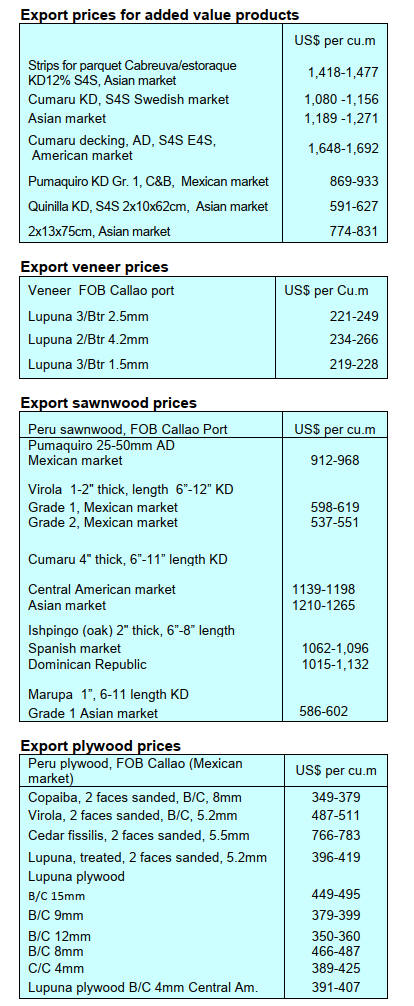
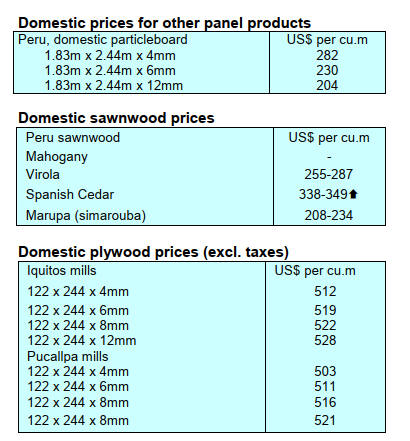
|